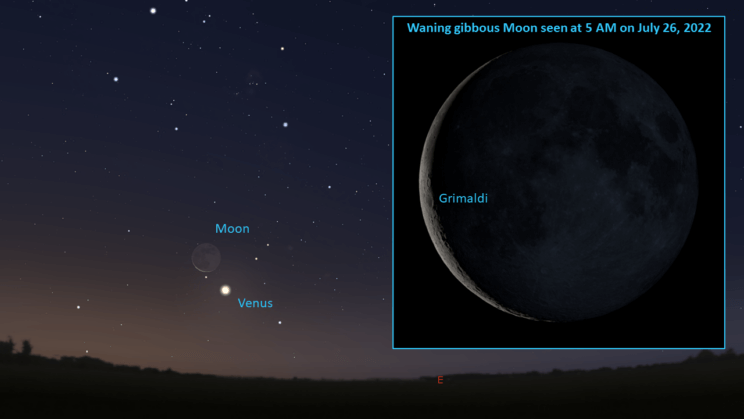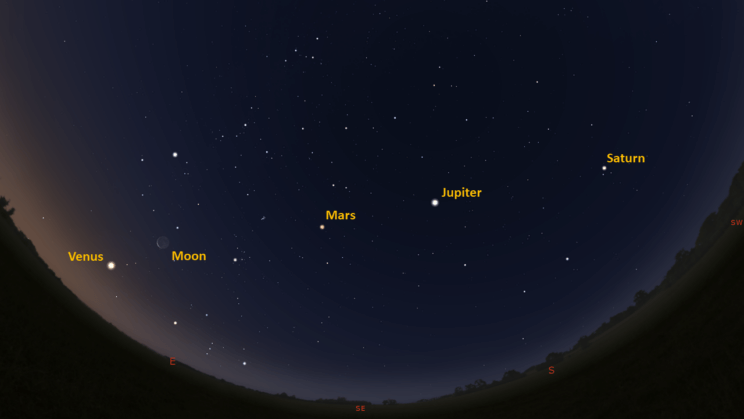This is the Saint Louis Science Center’s NIGHT SKY UPDATE for the week of Friday, July 22, 2022.
Information updated weekly or as needed.
Times given as local St. Louis time which is Central Daylight Time (CDT). For definitions of terminology used in the night sky update, click the highlighted text. If relying on times posted in Universal Time (UT), St. louis is -5 hours when CDT.
Public Telescope Viewings
Public telescope viewings at the McDonnell Planetarium have returned as part of the Saint Louis Science Center’s First Friday event. As we ease back into our telescope nights, they will operate a little different than before. To take part in our telescope viewings you will need to get a ticket for the planetarium show that starts at 7:00 p.m. as part of the First Friday event. Tickets for the First Friday planetarium show are free, but they can only be picked up at the Saint Louis Science Center on the night of the event. After the planetarium show ends you will be able to go outside and look through telescopes weather permitting. We will update this posting if anything changes.
Solar telescopes viewings have also returned and will take place every Sunday from 11:00 a.m. to 3:00 p.m. weather permitting. Solar Sundays will run from May 29, 2022, to September 4, 2022. The return of Solar Sundays is a good opportunity to prepare for the upcoming solar eclipses in 2023 and 2024.
Observing Highlight of the Week

The Moon and Venus will appear roughly 4° apart on July 26, 2022. With only 5% of the lunar surface visible, you should also notice something called Earthshine or Ashen Moon. This is when the nightside of the Moon facing Earth is dimly visible due to sunlight reflecting off Earth towards the Moon. Sky image simulated with Stellarium. Lunar image credit: NASA, SVS, Ernie Wright.
This week the Moon and Venus will be in conjunction on July 26, 2022, at 9:12 a.m. This happens after sunrise, but the pair will be a nice target by 5:00 a.m. Look for them rising in the east a little after 4:00 a.m. clearing trees by 5:00 a.m.
Conjunctions occur as two or more astronomical bodies share the same right ascension. Typically, a conjunction involves multiple planets or a planet and the Moon. Seeing a planet and the Moon in conjunction is common. Each month the Moon will slide by each planet in the sky as it completes is synodic cycle. On July 26, 2022, The Moon will appear a little over 4° to the north of Venus. Both objects will be easy to see together through binoculars.
Looking at the Moon on July 26, 2022, you will see a 27-day old moon. This is a waning crescent phase with only 5% of the lunar disk illuminated. Unfortunately, most of the Moon we see from Earth will be in nighttime leaving us only a few easy binocular targets to track down. The easiest lunar feature to look for on July 26, is Grimaldi Crater. This crater formed about 3.9 billion years ago. Due to its ancient age, Grimaldi’s crater walls are highly eroded. Looking at the crater though a telescope will reveal a dark central floor that is covered in mare basalt and the crater rim has been deteriorated to appear as a collection of hills ridges and peaks. Through binoculars, Grimaldi will standout due to the dark appearance of the crater floor.
Pointing a telescope at Venus will also reveal a phase. Due to Venus being closer to the Sun than Earth, it exhibits phases from our perspective. Venus is currently headed towards superior conjunction which means each day we are seeing a little more of Venus reflecting sunlight. Currently, Venus is exhibiting a gibbous phase with roughly 91% illumination.
The Moon and Venus will both be difficult to see if your eastern view is crowded with trees or buildings. If this describes your backyard view, I recommend finding a large parking lot nearby with an eastern view. While you track down Venus and the Moon, make sure to check out Mars, Jupiter and Saturn as they will also be visible.
The Sun and Moon

The Moon as seen from the International Space Station, on July 31, 2011.
Credit: NASA
Sunrise is at 5:54 a.m. on Friday, July 22 and sunset is at 8:20 p.m. providing us with roughly 14.5 hours of daylight. Even after sunset, the light from the Sun will dimly illuminate our sky for just under 2 hours. This period is called twilight, which ends around 10:10 p.m. this week. For those with a sundial, local noon occurs around 1:07 p.m. this week.
| Day | Sunrise | Sunset |
|---|---|---|
| 2022-07-22 | 5:54 a.m. | 8:20 p.m. |
| 2022-07-23 | 5:55 a.m. | 8:19 p.m. |
| 2022-07-24 | 5:56 a.m. | 8:18 p.m. |
| 2022-07-25 | 5:56 a.m. | 8:18 p.m. |
| 2022-07-26 | 5:57 a.m. | 8:17 p.m. |
| 2022-07-27 | 5:58 a.m. | 8:16 p.m. |
| 2022-07-28 | 5:59 a.m. | 8:15 p.m. |
| 2022-07-29 | 6:00 a.m. | 8:14 p.m. |
| 2022-07-30 | 6:01 a.m. | 8:13 p.m. |
Moon
Moonrise for Friday, July 22 occurred at 1:08 a.m. and moonset occurred at 3:38 p.m. The next moonrise occurs at 1:39 a.m. on the following day. On Friday, July 22, the Moon will exhibit a waning crescent phase with 27% of the lunar disk illuminated. New moon occurs on July 28, 2022, at 12:55 p.m.
International Space Station (ISS) Observing

There are numerous passes of ISS visible from St. Louis for the week of July 22. They occur during evening hours. The table below lists the best passes visible from St. Louis this week.
Catch ISS from St. Louis starting Friday, July 22
| Date | Starts | Max. altitude | Ends | |||||||
|---|---|---|---|---|---|---|---|---|---|---|
| Time | Alt. | Az. | Time | Alt. | Az. | Time | Alt. | Az. | ||
| 25 Jul | -1.9 | 22:31:42 | 10 | NNW | 22:34:27 | 23 | NNE | 22:34:48 | 23 | NE |
| 26 Jul | -1.4 | 21:43:31 | 10 | NNW | 21:45:48 | 17 | NNE | 21:47:57 | 11 | ENE |
| 26 Jul | -1.3 | 23:19:34 | 10 | NW | 23:20:49 | 21 | NW | 23:20:49 | 21 | NW |
| 27 Jul | -3 | 22:31:08 | 10 | NW | 22:34:00 | 49 | N | 22:34:00 | 49 | N |
| 28 Jul | -2.5 | 21:42:49 | 10 | NW | 21:45:53 | 32 | NNE | 21:47:14 | 23 | ENE |
| 29 Jul | -1.9 | 20:54:33 | 10 | NNW | 20:57:16 | 22 | NNE | 20:59:57 | 10 | E |
| 29 Jul | -2.6 | 22:30:55 | 10 | WNW | 22:33:23 | 39 | W | 22:33:23 | 39 | W |
| 30 Jul | -3.9 | 21:42:21 | 10 | NW | 21:45:42 | 89 | NE | 21:46:42 | 42 | SE |
Magnitude (Mag): The Measure of brightness for a celestial object. The lower the value is, the brighter the object will be.
Altitude (Alt): The angle of a celestial object measured upwards from the observer’s horizon.
Azimuth (Az): The direction of a celestial object, measured clockwise from an observer’s location with north being 0°, east being 90°, south being 180° and west being 270°.
For information about ISS flyovers and other visible satellites, visit www.heavens-above.com
Detailed information regarding all unmanned exploration of our universe, missions past, present, and planned, can be found at Jet Propulsion Laboratories:
The Visible Planets

Looking southeast at 5:00 a.m. July 25, 2022. Credit: Stellarium, EG
This week, four naked eye planets are visible. Venus, and Mars are best seen before sunrise in the east and southeast. Jupiter and Saturn are now rising before midnight and will be good targets by 1:00 a.m. in the southeastern and southern sky.
Venus
Venus has started a morning apparition and will be seen in the southeast before sunrise. Venus rises at 4:03 a.m. and should be easy to spot in the southeast by 5:00 a.m. The current morning apparition lasts until the third week of October 2022. Venus reaches superior conjunction on October 22, 2022.
Mars
Mars rises at 12:55 a.m. Start looking for the red planet around 2:00 a.m. as it clears trees and buildings. Mars will continue to climb out of the Sun’s glare as it heads towards opposition later this year on December 7, 2022.
Jupiter
Jupiter rises at 11:24 p.m. and should be visible by 12:30 a.m. As the year goes on, Jupiter will rise about 25 minutes earlier than it did the week before. Jupiter will reach opposition on September 26, 2022, so our best views of this giant world will come at the end of summer and through the fall months.
Saturn
This week Saturn will rise around 9:31 p.m. Start looking for Saturn around 10:30 p.m. in the southeastern sky. Saturn will reach opposition on August 14, 2022. As we head to this date, Saturn will rise earlier each day.
James S. McDonnell Planetarium
Night Sky Update: July 22 – July 30, 2022






